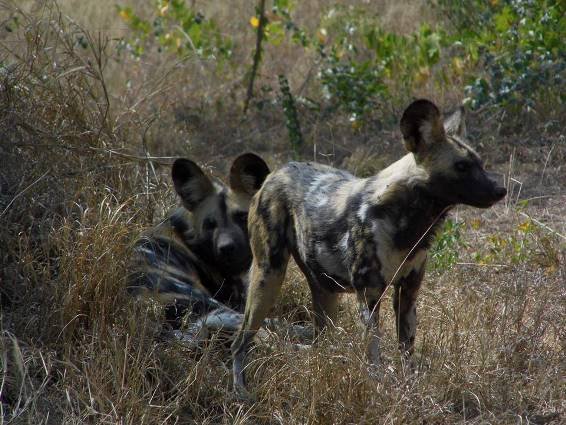African wild dogs

The African wild dog or Lycaon pictus, the painted wolf, a multicoloured canine, is disappearing. They no longer exist in 25 of the 39 African countries where they used to roam and hunt when nature was still secure in Africa. There may be fewer than 7000 wild dogs left on earth.
In South Africa wild dogs occur in only a few of the larger game reserves a couple of decades into the twenty first century. Deemed vermin, they were hunted and poisoned indiscriminately. People were paid by the Government in South Africa for every wild dog tail or carcass delivered. Killing wild dogs in the Kruger was only discontinued in 1931, elsewhere around 1970. Conservation efforts subsequently started, has improved considerably since 1997.
These social carnivores live and hunt in packs from 12 to 50. Some green leaves will be eaten, stimulating digestion, but antelope, mainly impala, even zebra are targeted as the main diet.
Said to be cruel hunters, they don’t necessarily kill before they eat. All hunting is cruel, every hunter focuses on efficiency in killing its prey according to its capabilities. The large pack of small, hard running wild dogs merely uses its particular attributes efficiently to overpower the prey. These attributes brought the wrath of humans upon them when they still operated normally in the open veld.
No stalking is resorted to in a wild dog hunt. Instead, a high-speed chase is launched by a spread-out line of hunters. They continue until their stamina counts. Wild dogs can reach speeds close to 70 km per hour and keep it up for nearly 2 km. Their usual hunting speed is 48 km per hour, which they can maintain for 5 km. Less than one third of their targeted victims get away. They live in open land, avoiding forest and mountain where pack running would be impaired.
When the chased antelope tires, it is often grabbed and held by its muzzle or lips. This is done by an intrepid front runner, neutralising victim defence of using horns. The chase of a few metres or a few kilometres is led by the alpha pair, the dominant male and female of the pack. All participants in the pack will tear pieces of meat from the running body until it drops.
The alphas will eat first, accompanied by the young of the pack, other adults waiting their turn. Wild dogs are caring and kind to the young of their pack. A disciplined lot, the lower ranks also rarely breed. Instead, they support the young of the alpha pair. There is little fighting in the pack, the hierarchy maintained mostly by peaceful means.
When the alpha female has young, members of the pack will regurgitate food for her while she can’t hunt. The next in line female will come into oestrus almost straight away should the alpha die.
When the pack becomes too large for all to eat, same sex groups break away in which a new alpha animal becomes dominant. The next step for such a group under its new leader is to meet a breakaway group of the opposite sex. In this way a new pack comes into existence (Riëtte, 2016; https://animals.net; www.bing.com).

